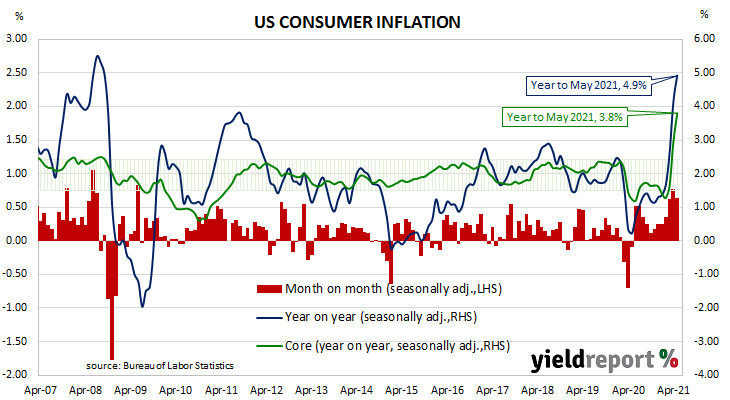Summary: US CPI rises noticeably in May; double expectations; “core” rate more than expected figure; most, not all, underlying drivers point to transitory factors; non-food/energy commodities, used car/truck prices main drivers; “inflation creep may be broadening”; risk of “more permanent lift” in inflation.
The annual rate of US inflation as measured by changes in the consumer price index (CPI) halved from nearly 3% in the period from July 2018 to February 2019. It then fluctuated in a range from 1.5% to 2.0% through 2019 before rising above 2.0% in the final months of that year. Substantially lower rates were reported from March 2020 to May 2020; falls in the index over these three months in 2020 are expected to raise annual inflation rates temporarily over the corresponding months in 2021.
The latest CPI figures released by the Bureau of Labor Statistics indicated seasonally-adjusted consumer prices rose by 0.6% on average in May. The result was double the 0.3% increase which had been generally expected but less than April’s 0.8% jump. On a 12-month basis, the inflation rate accelerated from April’s seasonally adjusted reading of 4.2% to 4.9%.

“Headline” inflation is known to be volatile and so references are often made to “core” inflation for analytical purposes. Core inflation, a measure of inflation which strips out the volatile food and energy components of the index, increased by 0.7% on a seasonally-adjusted basis for the month. The result was more than the expected 0.5% but less than April’s 0.9% increase. The annual rate accelerated again, from 3.0% to 3.8%.
NAB currency strategist Rodrigo Catril said “most, but not all of its underlying drivers pointing to transitory factors.” He noted the rise in core inflation was largely driven by increases used car prices, airfares fares and vehicle rentals.
Longer-term US Treasury bond yields fell on the day. By the close of business, the 10-year yield had lost 5bps to 1.44% and the 30-year yield had shed 4bps to 2.13%. The 2-year yield finished 1bp higher at 0.15%.
In terms of US Fed policy, expectations of any change in the federal funds range over the next 12 months remained fairly soft. June 2022 futures contracts implied an effective federal funds rate of 0.10%, only several basis points above the spot rate.

